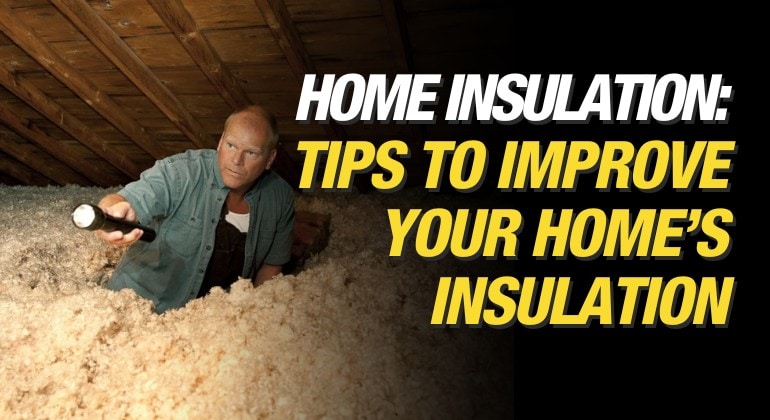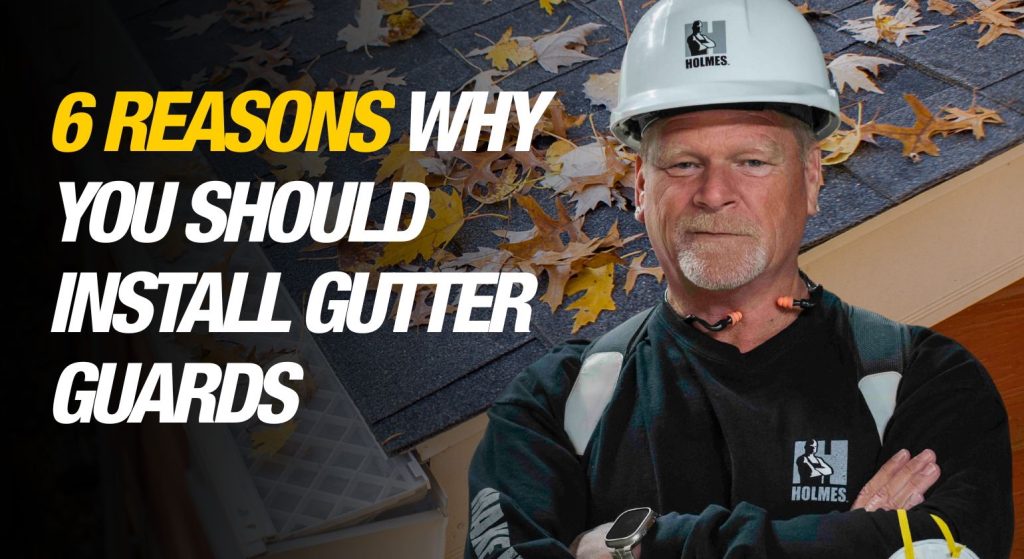Choosing the right siding for your home isn’t just about looks. I’ve said it a million times: PROTECT YOUR HOME FROM THE OUTSIDE IN. Siding is also about protection,...

How To Improve Your Home Insulation
By Mike Holmes
Mike’s Advice / Home Renovation
Friday, September 1st, 2023 @ 12:30pm
Tips on How to Better Insulate Your Home
Do your energy bills spike during the winter and in the summer when the AC is on? You may not have proper home insulation. A well-insulated home saves money on energy bills and is more energy efficient. It will also make you more comfortable in every season.
Generally speaking, newer homes have better insulation than older homes because building energy codes have been improving over the years. If you own an older home, you probably need to look into upgrading your existing insulation. We have fixed a lot of homes with missing insulation.
Should I Add Insulation To My House?
To put it simply, insulation reduces the transfer of heat into or out of your home. Insulation traps tiny pockets of air to slow down the movement of heat out of the house in the winter and into the house in summer. You may have heard of the term “R-value”. This is a measure of how well the insulation traps the pockets of air. The higher the number, the better the insulation is at resisting heat transfer.
There are a few different types of insulation materials (fibreglass, polystyrene, mineral wool, etc.). There are also different methods of applying it (spray foam insulation, loose-fill, rolls of batting, and more).
A well-sealed envelope, paired with the right amount of insulation, can make a real difference in your utility bills. According to Energy Star, if you add up all the leaks, holes and gaps in a typical home’s envelope, it would be the same as having a window open every day of the year.
Improve Overall Comfort – Seal and Insulate
Sealing leaks and adding insulation can improve the overall comfort of your home. Those two things can actually help with other common issues in homes such as:
- Reduced noise from outside
- Limits pollen, dust, and insects (or pests) intrusion
- Better humidity control
- Lower chance for ice dams on the roof in in the winter
RELATED:
Is My Home Under Insulated?
Insulation is important because of its ability to reduce the amount of heat that flows between the inside and outside of your home.
These are some signs that your house may be under-insulated:
- Icicles hanging from your roof. This can indicate that your attic is not sufficiently insulated.
- Big changes in temperature from one room to another
- Energy bills are very high in the winter and when your AC is running
BONUS TIP
If you see snow on your roof, that’s actually a good thing because it means your insulation is doing its job. When heat escapes from the top of your home, it can cause the snow to melt. This will then refreeze on a cold spot on your roof leading to dangerous ice dams. When that happens, eventually you could see water start to back up into your home and start causing some big damage.

If you see snow on your roof, that’s actually a good thing because it means your insulation is doing its job.
I recommend hiring a qualified home energy auditor to conduct a whole-home energy assessment. This should include an insulation check.
READ MORE:
Before You Insulate Your Home
Before you look into insulating your house, you need to seal all areas where there is air leakage and drafts. This alone will have a huge impact on your energy bills.
If you are insulating your basement, you should know that moisture is a problem. If you don’t deal with moisture in your basement, it can seep into the insulation, drywall, wood ,etc. This can cause a LOT of damage.
What Is R-Value?
You may have heard me talk about R-value on my shows. R-value is the ability of your insulation material to reduce heat flow. The higher the R-value, the more this heat flow is reduced.
If your home already has insulation installed, a certified contractor can assess your home’s current R-value. They can recommend whether additional R-value is needed and the insulation options suitable for your home.
How Much Can You Save by Insulating Your Home?
Almost half of your energy bill is spent on heating and cooling. On average, you can save up to 20% on your home’s heating and cooling costs or up to 10% on its total energy costs by adding insulation to attics, floors, crawl spaces, and accessible basement rim joists, and by reducing unwanted air leaks all around your house.
(Source: U.S. Department of Energy)
What part of a house should you insulate first?
If you need to prioritize where to add insulation to your home, here is a guide.
#1 Attic Insulation
More heat escapes through your attic than anywhere else in your house. Adding insulation to your attic can save you a good amount of money in energy costs.
After a snowfall, take a look at the roof. If you see any bare spots, that’s a sign your attic is allowing heat to escape. Not good. Some bare spots around venting are natural, but if you spot shingles elsewhere, it’s time to beef up your attic’s insulation.

If you’ve got snow on your roof you need to find out if your attic is doing its job.
Insulating your attic can add value to your home.
Will adding insulation to your attic make a difference?
To answer this simply, YES. Increasing attic insulation is going to be one of the single most important steps you can take to save on your energy bills.
If the insulation in your attic is less than an equivalent of R-30 (about 10 to 13 inches), I recommend adding more. Upgrading an under-insulated home is well worth the expense.
#2 Insulating Your Crawl Space
If your crawl space is insulated, your heating ducts and water pipes in the crawlspace will not have to be insulated and won’t freeze. You also prevent heat loss from the ducts.
To insulate your crawl space, I recommend using a closed-cell, two-pound spray foam. This will act as both your vapor barrier and insulation.

If you live in an older home with a crawl space, you want to know what’s going on under your floors, Mike Holmes writes.
You will also need insulation under the floor of your home to keep the cold air underground and stop it from meeting the warm air in the warm part of the house.
RELATED:
#3 Insulating Your Basement
Insulating your basement from the inside has a lot of benefits. For existing homes, this makes a lot of sense and is cheaper than insulating from the outside. Adding insulation also prevents insect infestations.
Closed-cell spray foam is an effective way to insulate your concrete basement walls. It can achieve a higher R-value. It also provides moisture resistance, which is important in a basement.
Insulating a basement can be an easy way to improve your home’s energy efficiency. This is especially true for older homes.
RELATED:
#4 Exterior Wall Insulation
If your attic has enough insulation and you have done all the steps to properly air-seal your house, you may need to look into exterior wall insulation. This is an expensive job for existing homes.
Keep in mind that you may need to allow extra time if you need to excavate, repair foundation cracks, or waterproof the exterior foundation walls.

Remember, Mike Holmes Jr.’s walls weren’t thick enough to bring the R-Value up to code. We solved that by also insulating from the outside. If you can insulate and thermal break the house from the outside, the inside air, stays inside.
Three types of insulation are used on the exterior of basement walls:
- Rigid mineral wool boards,
- High-density polystyrene (Type IV) and
- Polyurethane/polyisocyanurate boards
#5 Windows And Doors Insulation
When it comes to designing a well-insulated home, you need to pay attention to more than just the walls and ceilings. Windows and doors are important parts to avoid heat loss and cold drafts.
The first step is to examine your window and door frames and apply weatherstripping or caulking to fill any gaps or cracks. Use a high-quality expanding foam insulation that is great for sealing those gaps —both the ones that are harder to reach and wider gaps.
And don’t ignore the attic and basement windows. Insulating these can help maintain a consistent comfortable indoor temperature.
Replacing Old Windows & Doors
If you have older windows, consider replacing them with more energy-efficient ones. For example, double or triple glazing, Low-E coatings, and gas-filled glass. This upgrade will improve your home’s energy efficiency, improve its insulation, and increase your home’s value.

Home renovation with big windows completed by Lexis Homes, Holmes Approved Homes builder.
When it comes to doors, choose a model with weatherstripping and solid cores to minimize heat transfer.
Storm windows and doors give an extra layer of protection in harsh weather, further reducing your utility bills.
Finally, be sure to do annual maintenance checks to keep your window and door insulation in good shape. This will contribute to long-term energy savings and a cozy, energy-efficient home.
RELATED:
5 Signs Your Windows Needs Replacing
Installing Insulation
Installing insulation is not a DIY job. You need to hire a certified insulation installer.
You may have seen DIY spray foam kits in the market. I don’t recommend using those. Hiring a pro is always the best idea.
How Much Does It Cost To Insulate Your House?
The cost of adding insulation depends on the R-value and the type of insulation. Get in touch with a professional insulation installer to get quotes.
By addressing insulation needs and sealing air leaks, you can create a more energy-efficient and comfortable home for years to come. You will also enjoy energy savings on your monthly bills!
READ NEXT:
Types of Insulation
Your choice may depend on which part of the house you’re insulating, and if you have easy access to the space. For example, to insulate a wood stud wall, you’ll have far more choices during new construction, or renovations where the wall cavity is open than if you want to insulate a wall cavity without removing the drywall.
Spray Foam Insulation
Spray foam does a great job of creating an airtight home. It has a high R-value. With airtight homes, however, you do need to consider proper ventilation strategies so moist air is not trapped inside.
The best way to do this is to install an HRV (Heat Recovery Ventilator) or an ERV (Energy Recovery Ventilator). What an HRV does is that it exchanges indoor air with fresh outdoor air. But it also pre-heats the air that comes in using the air that’s going out.
Closed-cell spray foam insulation creates an effective air seal and thermal barrier when sprayed into the joist bays above the crawl space. This needs to be done by a professional. There are DIY spray foam kits in the market, but I don’t recommend messing around with stuff you don’t know.
RELATED:
Open Cell and Closed Cell Spray Foam
When discussing spray foam, there are two types: open-cell and closed-cell. Open-cell spray foam consists of foam cells that are not completely closed, allowing it to be crushed by hand. On the other hand, closed-cell spray foam contains tightly packed, closed foam cells, rendering it denser and rock solid. This density contributes to an increased R-value, which measures its resistance to heat loss.
ICF
Insulated Concrete Forms (ICF) are becoming a more common home construction option. This innovative building material is typically made out of polystyrene foam blocks with room in between for a concrete wall to be poured. However, like any other structure, it must be protected from the elements and UV damage.
Blow-In Insulation
This is the best option for your attic. It is cheaper than fiberglass and has a higher R-value. It is less expensive than fiberglass and has a higher R-value. How it works is bags of cellulose need to be emptied into a blower. This equipment then sends the fluffed-up insulation through a long hose.
Foam Board or Rigid Foam
When it comes to insulation, foam board or rigid foam is a great, high-quality option you can’t go wrong with. These boards are known for their high heat resistance and are manufactured from materials such as polystyrene, polyisocyanurate, or polyurethane.
What’s great about foam boards is their adaptability. They can be used in several places in your house, including walls, roofs, floors, and basements. It’s also great for insulating concrete slabs. Here’s the best part. Thanks to its firm structure, it will not sag or settle with time, maintaining its efficiency.
Foam board insulation also has a high R-value, which means it’s able to keep your home comfortable, reducing the risk of heat loss or cold drafts coming in. It creates a continuous barrier against heat transfer, which results in lower energy costs and a more comfortable home.
But here’s the thing: installation is important. To maximize performance, seams and edges must be well sealed. That’s why it’s best to hire a professional installer for this job.
Whether you want to keep your house warm in the winter, cool in the summer, or simply cut back on your energy expenses, the right insulation can make all the difference. From foam board and fiberglass to cutting-edge solutions like ICF, there is an insulation material for every need. Investing in proper insulation is an investment in the future of your home. Remember that some projects are better left to the professionals – this is a big investment, so you want to make sure it’s done right the first time.
READ NEXT:
Indoor Fall House Maintenance Checklist










